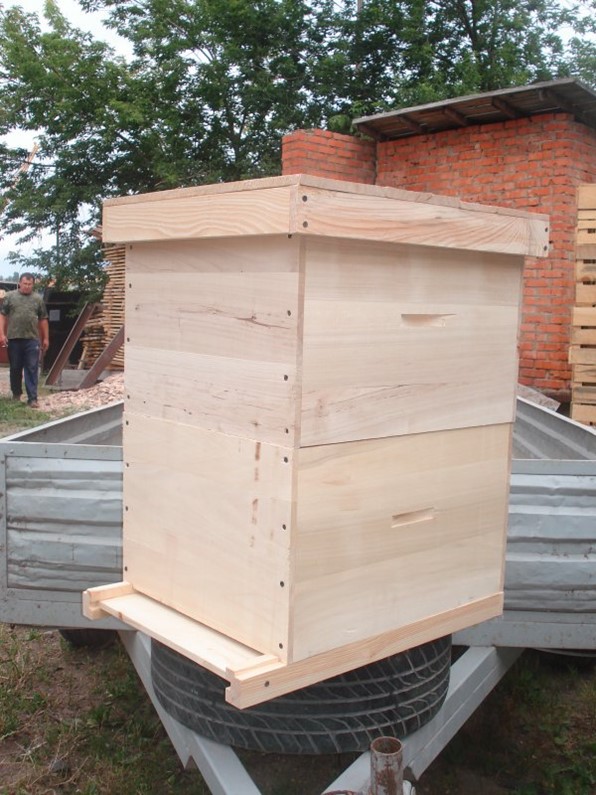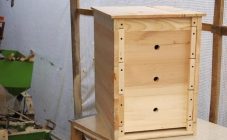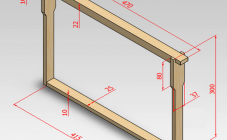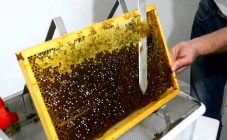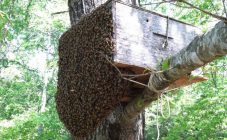Content:
Today in beekeeping, various models of hives are used, each of which has certain design features. Today, one of the common housing options for bees is the Ruta hive.
Ruta beehive for 10 frames
The Ruta hive is a unique bee dwelling by design, as it uses the same shops. Thanks to this feature, the beekeeper can turn the store into a full-fledged nest at any time. True, you need to add the necessary elements.
The standard dimensions of the Ruta beehive 10 frames are 446x232 mm. Depending on the frames used, there may be different cases, but most often a 10-frame case is used for standard Ruta elements.
A distinctive feature of the design that Langstroth worked on is the reduced width, which makes the bee house more compact. Large nest compartments increase the fertility of the queens. The family of bees grows very quickly, and with it the volume of honey obtained increases.
The principle of using Langstron-Root hives is very simple - it is based on the natural behavior of bees:
- After winter, the body where the bees were located moves to the second tier with frames. It is filled with dry and wax. After hibernation, everyone wants to move to a warmer place, here after a while a uterus appears.
- Then the housings are interchanged and an empty one is installed between them.
- After 2-3 weeks, when the family has fully recovered after winter, the buildings should be swapped again, and an empty one should be added to the center.
- Bees fill the empty space again. In this case, the body with the uterus should be covered with a net through which a working insect, but not the uterus, can penetrate.
Due to the fact that bees are constantly busy restoring their homes, they have little time to prepare for wintering. But many beekeepers have found a way out of this situation. They feed the hard workers with sugar in winter.
What are the differences between Ruta hives and Dadan
To understand what the differences are between Dadan and Ruth hives, one should understand the design features of the first.
The main difference between Dadan hives and Ruta is in the peculiarities of beekeeping. There are differences not only in the principles of maintenance, but also in the structure of the hive itself and the method of removing a valuable product. On the drawing of the Ruth hive for 10 frames, all the differences are immediately visible.
The Dadan hive consists of 12 frames with dimensions of 300x435 mm and magazines with half frames with dimensions of 145x435 mm.
The procedure for using these hives is as follows:
- During wintering, the family is located in one nest.
- At the end of winter, bees are fed with sugar.
- In the spring, they check the family, carry out exhibition work, put a frame with foundation.
- After the insects get stronger, a store with frames is added.
- Bees begin to fill them in preparation for winter. After filling, you can withdraw honey.
- Additionally, you can put frames instead of a store, as some people use an additional store.
As you can see, there are several systems for working with Dadan hives, the beekeeper himself determines the most acceptable for himself, while many factors should be taken into account: climatic conditions, the level of experience of the beekeeper, and so on.
Which is better
There is no unequivocal answer to the question of which hive is better than Dadan or Ruta. Each of them has its own characteristics. When choosing one of these options, it should be remembered that replacing the complete set and purchasing new houses is a rather costly business, so you should decide before buying which beekeeping system will be used.
Wintering of bees in one building Ruta
A multi-hive rutovsky hive, with proper assembly, nest organization, sufficient food and without the presence of diseases, is very convenient for organizing the wintering of bees.
Strong and medium-sized families hibernate in two buildings, for small families the wintering of bees is organized in one Ruta building. In the upper section, a compressed nest is collected on full-sized combs so that insects can overwinter in it.
When organizing a compressed nest, the number of honeycombs filled with honey should be 1 less than the number of bee streets. To reflect heat back into the body, Guillaume barrier boards are used, which are installed on both sides of the walls. In the lower case, no more than 5 cells should be placed, which are small. Honey, which the bee family will need for wintering, should be stored in storerooms.
To organize a warm home, proceed as follows:
- Insulation and PVC film are placed on the frames of the upper case. They form a nice warm hat.
- A round tap hole opens in the upper case, as well as a slot in the bottom.
- Due to the fact that the saturated exhaust air of CO will go out through the upper opening, steam will not collect inside, therefore, there is no need to worry about the appearance of dampness.
Ruta hive: beekeeping techniques
The use of tiered hives is aimed at increasing the honey, without the need to focus on the maintenance of each individual family. Thanks to the design features, it turns out to work with many families together. Without paying attention to each, only a small number of queens are being examined in a frame-by-frame manner.
With this method of breeding bees, examinations are carried out as follows:
- Several frames are examined;
- Based on the results of the inspection, the necessary actions are determined (removed, substituted).
In general, intensive beekeeping using Ruta hives is rougher, but most effective. There are several methods that can help you achieve different goals:
- If you put the body on top, then as a result it will very quickly fill with honey (with good knitting).
- If it is installed in the central part, the natural instinct will leap in insects, and they very quickly unite the nest into a single whole.
- Lowering the body down will help protect the bees from hypothermia. It will only fill up when new free space is needed.
Loose hives should be selected due to infrequent inspections. This will help prevent swarms from forming. This is not allowed. First, they are smoothly removed from the family of queens, then the families are separated. Actions must be carried out simultaneously. Replacement of queens is carried out in a similar way.
Ruta beekeeping system
Ruta's multi-body beekeeping system is to ignore the nuances of the development of individual families. For separation of the uterus in two buildings, a special Hahnemannian lattice is used. It divides the uterus into different bodies.
The Ruta beekeeping system has a certain disadvantage - bees will constantly need to penetrate through the bars.This slightly reduces the productivity and life span of insects.
The advantages of a multi-body beekeeping system are much greater:
- Originally known where there is no queen in the hive;
- It is very convenient to sort the frames for rejection, the larvae will not be located in them;
- There are no frames for pumping and in which there is brood;
- The owner himself decides which comb to fill with honey, and which - syrup for wintering.
Due to the fact that ready-made rutovsky hives have typical sizes, it is much easier to carry out selection-additive-replacement processes.
Ruta multi-hive hives came to beekeeping in Soviet times, but today they do not lose their relevance, thanks to a well-thought-out design.

